Microbial Genetics - Formation of Mutants | 12th Microbiology : Chapter 12 : Microbial Genetics
Chapter: 12th Microbiology : Chapter 12 : Microbial Genetics
Formation of Mutants
Formation of Mutants
The term
mutant refers to an organism in which either the base sequence of DNA or the
phenotype has been changed. A mutant is an organism whose genotype differs from
that found in nature. The process of formation of mutant organism is called
mutagenesis. In nature and in the laboratory, mutations sometimes arise
spontaneously, without any help from the experimenter. This is called
spontaneous mutagenesis. The two mechanisms that are most important for
spontaneous mutagenesis are
1. Errors occurring during
replication and
2.
Spontaneous alteration of bases.
Mutations
can also be induced experimentally by application of mutagens. Mutagens are
agents that cause mutations.
Mutagens and their Mode of Action
Physical Mutagens
UV radiation: UV light causes mutations because the purine and pyrimidine
bases in DNA absorb light strongly in the ultraviolet range (254 to 260 nm). At
this wavelength, UV light induces point mutations primarily by causing
photochemical changes in the DNA. One of the effects of UV radiation on DNA is
the formation of abnormal chemical bonds between adjacent pyrimidine molecules
in the same strand, or between pyrimidines on the opposite strands, of the
double helix. This bonding is induced mostly between adjacent thymines, forming
what are called thymine dimers (Figure 12.10), usually designated TT. This
unusual pairing produces a bulge in the DNA strand and disrupts the normal
pairing of T’s (thymines) with corresponding A’s(adenines) on the opposite
strand. If UV induced genetic damage is not repaired, mutations or cell death
may result
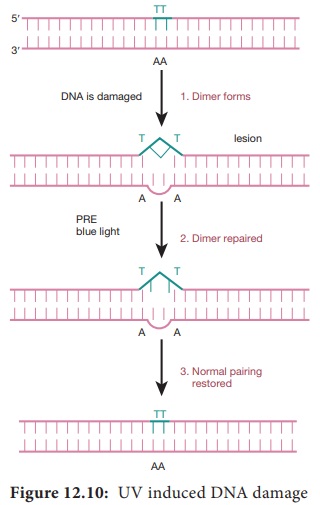
Chemical Mutagens
Chemical
mutagens include both naturally occurring chemicals and synthetic substances.
These mutagens can be grouped into different classes on the basis of their
mechanism of action. They are
i. Base analogs are bases that are similar to the bases normally found in DNA.
E.g. 5 – bromouracil (5-BU). TA to CG (Figure 12.11).
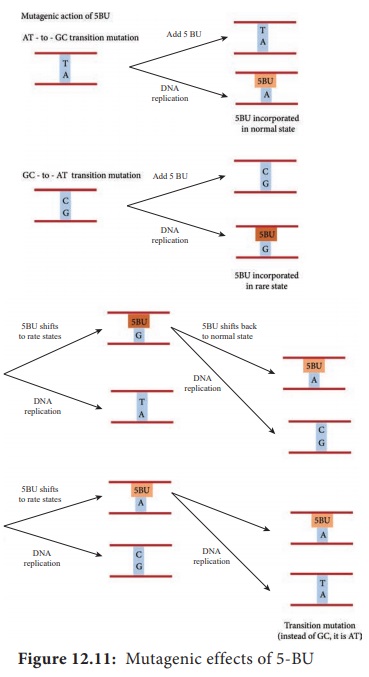
Not all base analogs are mutagens.For
example, AZT (Azidothymidine), one of the approved drugs given to patients with
AIDS, is an analog of thymidine, but it is not a mutagen, because it does not
cause base pair changes.
ii. Base
Modifying Agents are chemical
that act as mutagens by modifying the chemical structure and properties of
bases. The three types of mutagens that work in this way are
1. A
deaminating agent e.g.: Nitrous acid removes amino groups (- NH2)
from the bases guanine, cytosine, and adenine.
2.
Hydroxylamine (NH2 OH) is a hydroxylating mutagen that react specifically
with cytosine, modifying it by adding a hydroxyl group (OH) so that it can pair
solely with adenine instead of with guanine.
3. Alkylating agents like methymethane sulfonate
(MMS) introduces alkyl groups onto the bases at a number of location.
iii. Intercalating agents
Acridine, proflavin, ethidium bromide are a few
examples of intercalating agents. These insert (intercalate) themselves between
adjacent bases in one or both strands of the DNA double helix. Intercalating
agents can cause either additions or deletions
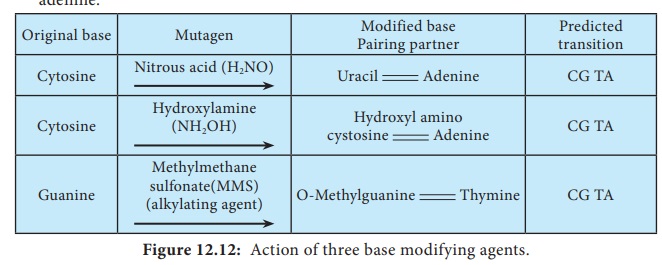
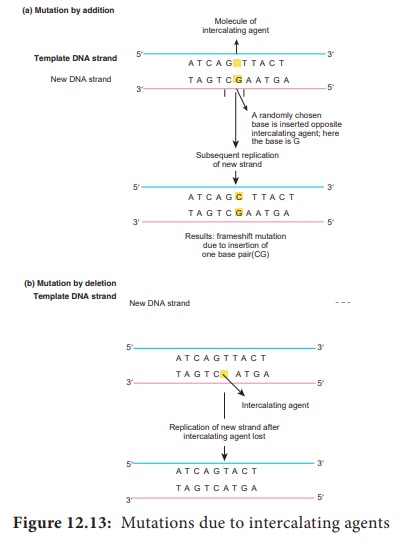
Infobits
Isolation and detection of Mutants
Once mutations are induced, then,
they must be detected if they are to be studied. Selection and screening
procedures historically have helped geneticists isolate mutants of interest
from a heterogenous mixture in a mutagenized population. When isolating mutants
of a particular organism, one must know the normal or wild type characteristics
so as to recognize an altered phenotype. A suitable detection system for the
mutant phenotype under study also is needed. Detection systems in bacteria and
other haploid organisms are straightforward because any new allele should be
seen immediately, even if it is recessive mutation. The detection of mutants
can be direct and complex. For example, the replica plating technique is used
to detect auxotrophic mutants (mutants which are deficient in synthesizing a
particular biochemical compound). Replica
plating technique distinguishes between mutant and wild type strain based
on their ability to grow in the absence of a particular biosynthetic end
product Figure below. A lysine auxotroph, for instance, will grow on lysine
supplemented media but not on a medium lacking an adequate supply of lysine
because it cannot synthesize this amino acid
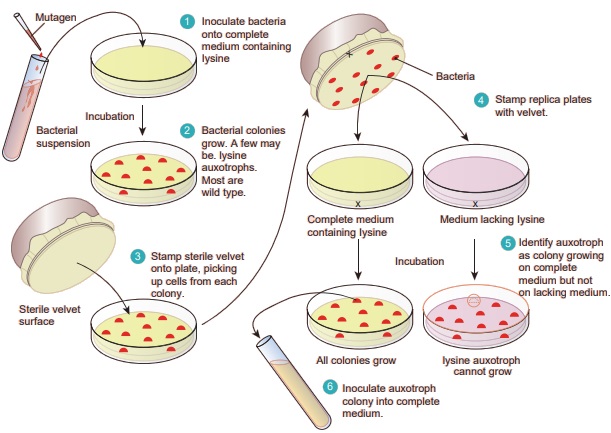
The Ames Test: A Screen for Potential Carcinogens
Everyday
we are exposed to a wide variety of chemicals in our environment, such as
drugs,cosmetics,foodadditives,pesticides, and industrial compounds. Many of
these chemicals can have mutagenic effects, including genetic diseases and
cancer. Some banned chemical warfare agents (e.g. mustard gas) also are
mutagens.
A number of chemicals (subclass of mutagens) induce
mutations that result in tumorous or cancerous growth. These carcinogens Directly
testing the chemicals for their ability to cause tumors in animal is time
consuming and expensive however mutagens led bruce ames to develop a simple
general ames test is an indicator ofwhether assavs the ability of chemicals to
rever mutant strains of the bacterium salmonella styphrium is auxotrophic to
histidine his that is requires histidine its growth and cannot grow in the
absence of histidine. The mutant strain is grown in a histidine deficient
medium containing the chemical to be tested. A control plate is also set up
which does not contain the chemical. After incubation the control plates may
have few colonies resulting from spontaneous reversion of the his- strain.
Compared to the control plates if there are increased number of colonies on test
plate, it indicates that the chemical has reverted the mutant strain back to
wild type. This chemical is likely to be a carcinogen. Figure 12.14 shows steps
in Ames test.
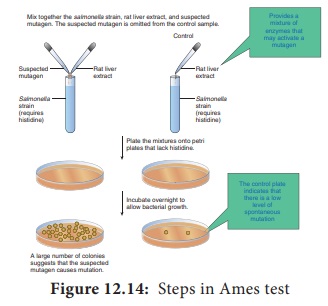
Infobits
DNA Repair
Both prokaryotes and eukaryotes have a number of repair systems
that deal with different kinds of DNA damage. All the systems use enzymes to
make correction. Without this repair systems lesions would accumulate and be
lethal to the cell or organism. Not all lesions are repaired, and mutations do
appear, but at low frequencies. At high doses of mutagens, repair systems are
unable to correct all of the damage, and cell death may result. We can group
repair systems into different categories on the basis of the way they operate.
Some systems correct damaged areas by reversing the damage. This type of repair
is called direct correction or direct reversal. Other systems excise the
damaged areas and then repair the gap by new DNA synthesis of the DNA repair.
Some systems are
• Mismatch repair by DNA
polymerase proofreading
• Repair of UV induced pyrimidine dimers- Photo reactivation or
Light repair
• Base excision repair
• Nucleotide excision
repair
With recombinant DNA technology it is possible to mutate a gene at specific
posi-tions in the test tube by SITE SPECIFIC MUTAGENESIS and then introduce the
mutated gene back into the cell and investigate the pheno-typic changes
produced by the mutation in vivo. Such techniques enable geneti-cists to study,
for example, genes with un-known function and specific sequences involved in
regulating a gene’s expression.
Related Topics